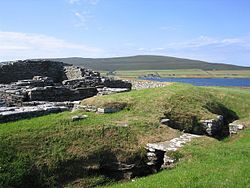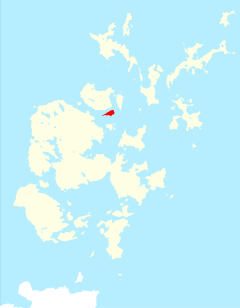Wyre, Orkney: Difference between revisions
Created page with '{{Infobox island |name=Wyre |norse=Vígr |county=Orkney |picture=Cubby Roo's Castle.jpg |picture caption=Cubbie Roo's Castle |os grid ref=HY445262 |area=768 acres |highest height…' |
mNo edit summary |
||
| (2 intermediate revisions by the same user not shown) | |||
| Line 5: | Line 5: | ||
|picture=Cubby Roo's Castle.jpg | |picture=Cubby Roo's Castle.jpg | ||
|picture caption=Cubbie Roo's Castle | |picture caption=Cubbie Roo's Castle | ||
|map=Wyre Orkney.svg | |||
|os grid ref=HY445262 | |os grid ref=HY445262 | ||
|area=768 acres | |area=768 acres | ||
|highest | |highest point=105 feet | ||
|population=18 | |population=18 | ||
}} | }} | ||
| Line 19: | Line 20: | ||
Bishop Bjarni grew up on Wyre, and was the son of Kolbein Hruga ("Cubbie Roo"): | Bishop Bjarni grew up on Wyre, and was the son of Kolbein Hruga ("Cubbie Roo"): | ||
< | <blockquote>[Bjarni] composed the only significant work of Norse poetry to have survived in the [Orkney] islands, his ''Lay of the Jomsvikings''. He also played an important part in securing the canonisation of Earl Rognvald." <ref name=Keay>Keay, J. & Keay, J. (1994) ''Collins Encyclopaedia of Scotland''. London. HarperCollins.</ref></blockquote> | ||
The poet Edwin Muir (1887–1959), known for his prominent part in the Scottish Renaissance, born in [[Deerness, Orkney|Deerness]] on [[Mainland, Orkney]] [http://famouspoetsandpoems.com/poets/edwin_muir/biography], spent much of his childhood on Wyre. In his autobiography he said of himself - "I'm an Orkneyman, a good Scandinavian",<ref name=Smith>{{cite book| author=Haswell-Smith, Hamish| year=2004| title=The Scottish Islands| location=Edinburgh| publisher=Canongate| isbn=}}</ref> and commented that some of his happiest childhood years were spent here.<ref name=Keay>Keay, J. & Keay, J. (1994) ''Collins Encyclopaedia of Scotland''. London. HarperCollins.</ref> | The poet Edwin Muir (1887–1959), known for his prominent part in the Scottish Renaissance, born in [[Deerness, Orkney|Deerness]] on [[Mainland, Orkney]] [http://famouspoetsandpoems.com/poets/edwin_muir/biography], spent much of his childhood on Wyre. In his autobiography he said of himself - "I'm an Orkneyman, a good Scandinavian",<ref name=Smith>{{cite book| author=Haswell-Smith, Hamish| year=2004| title=The Scottish Islands| location=Edinburgh| publisher=Canongate| isbn=}}</ref> and commented that some of his happiest childhood years were spent here.<ref name=Keay>Keay, J. & Keay, J. (1994) ''Collins Encyclopaedia of Scotland''. London. HarperCollins.</ref> | ||
Latest revision as of 07:57, 1 September 2012
| Wyre | |
 Cubbie Roo's Castle | |
|---|---|
| Location | |
| Grid reference: | HY445262 |
| Area: | 768 acres |
| Highest point: | 105 feet |
| Data | |
| Population: | 18 |
Wyre, also formerly spelt Weir, is an island of Orkney, lying south-east of Rousay. It is 768 acres and reaches just 105 feet above sea level at its highest point. Wyre is one of the smallest of the county's inhabited islands.
Ferries sail from the island to Tingwall on Mainland, and on to Egilsay and Rousay.
History
Wyre's history is still very apparent, and it has two ancient monuments maintained by Historic Scotland: Cubbie Roo's Castle and St Mary's Chapel.
Bishop Bjarni grew up on Wyre, and was the son of Kolbein Hruga ("Cubbie Roo"):
[Bjarni] composed the only significant work of Norse poetry to have survived in the [Orkney] islands, his Lay of the Jomsvikings. He also played an important part in securing the canonisation of Earl Rognvald." [1]
The poet Edwin Muir (1887–1959), known for his prominent part in the Scottish Renaissance, born in Deerness on Mainland, Orkney [1], spent much of his childhood on Wyre. In his autobiography he said of himself - "I'm an Orkneyman, a good Scandinavian",[2] and commented that some of his happiest childhood years were spent here.[1]
Cubbie Roo's Castle
Cubbie Roo's Castle, built in about 1150, is one of the oldest castles in Scotland and was mentioned in the Orkneyinga Saga. It takes its name from Kolbein Hruga who was said to have lived there.[2]
In King Haakon's saga, it is mentioned that after the last Norse Earl of Orkney, Earl John, was murdered in Thurso, his killers fled to Wyre. They took refuge in the castle, which was so strong that the besiegers had to thrash out a treaty with them to get them out.[2]
St Mary's Chapel
In the centre of the island is the roofless, but largely complete, twelfth century St Mary's Chapel. Its architecture is Romanesque and demonstrates that the Norsemen, notwithstanding their violent reputation, had a cosmopolitan cultural influence. It has been partly restored.[2]
Geography and geology
Like most of Orkney, Wyre is made up of Old Red Sandstone of the Devonian period.[2]
The island is low lying, and is shaped like an isosceles triangle on its side. It is generally low lying, and is separated from Rousay by Wyre Sound.
Rousay is to the north, Gairsay to the south, Mainland to the south west and Shapinsay to the south east.
Wildlife
Wyre is also known for its grey and common seals, and for birdlife including divers and ducks.
Footnotes
Outside links
| Islands of Orkney |
|---|
|
Inhabited islands: |
